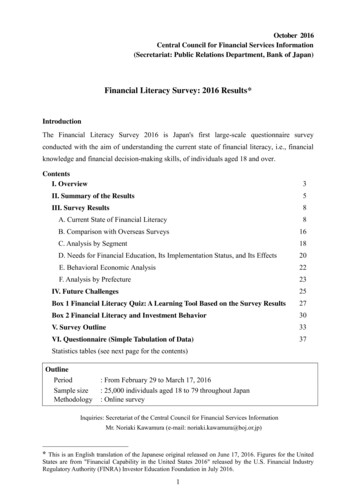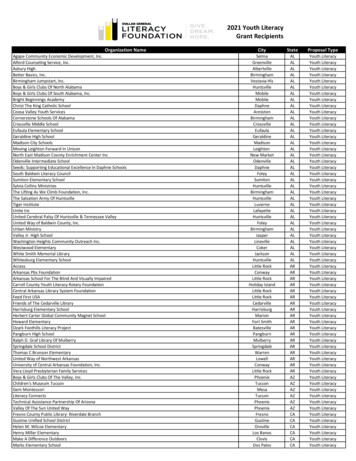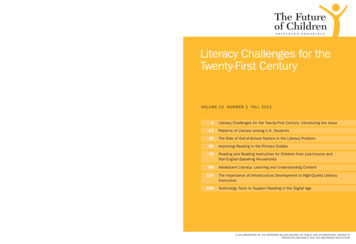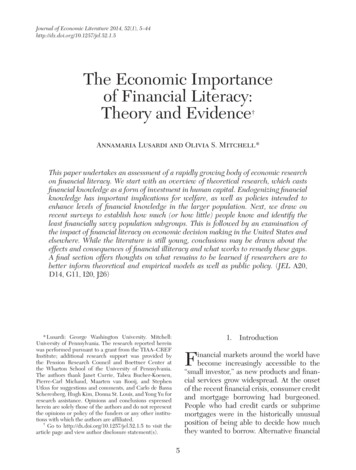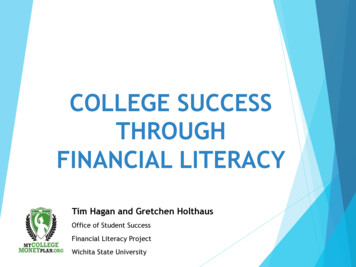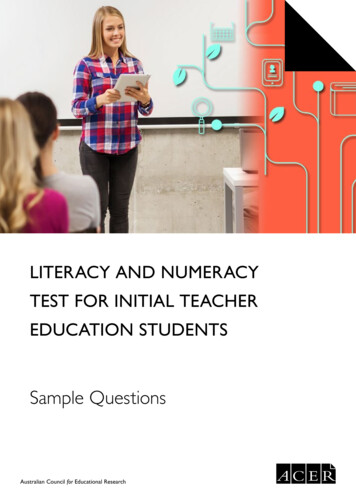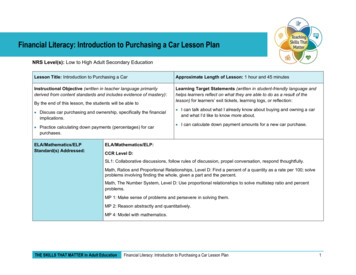
Transcription
Financial Literacy: Introduction to Purchasing a Car Lesson PlanNRS Level(s): Low to High Adult Secondary EducationLesson Title: Introduction to Purchasing a CarApproximate Length of Lesson: 1 hour and 45 minutesInstructional Objective (written in teacher language primarilyderived from content standards and includes evidence of mastery):Learning Target Statements (written in student-friendly language andhelps learners reflect on what they are able to do as a result of thelesson) for learners’ exit tickets, learning logs, or reflection:By the end of this lesson, the students will be able to Discuss car purchasing and ownership, specifically the financialimplications. Practice calculating down payments (percentages) for carpurchases.ELA/Mathematics/ELPStandard(s) Addressed: I can talk about what I already know about buying and owning a carand what I’d like to know more about. I can calculate down payment amounts for a new car purchase.ELA/Mathematics/ELP:CCR Level D:SL1: Collaborative discussions, follow rules of discussion, propel conversation, respond thoughtfully.Math, Ratios and Proportional Relationships, Level D: Find a percent of a quantity as a rate per 100; solveproblems involving finding the whole, given a part and the percent.Math, The Number System, Level D: Use proportional relationships to solve multistep ratio and percentproblems.MP 1: Make sense of problems and persevere in solving them.MP 2: Reason abstractly and quantitatively.MP 4: Model with mathematics.THE SKILLS THAT MATTER in Adult EducationFinancial Literacy: Introduction to Purchasing a Car Lesson Plan1
Central Skills Taught: Adaptability and Willingness to Learn Problem-Solving Communication Processing and Analyzing Information Critical Thinking Respecting Differences and Diversity Interpersonal Skills Self-Awareness Navigating SystemsLanguage Demands:Vocabulary specific to car finances(Include academic language,language skills, etc.)negotiate, down payment, interest, trade-inLanguage useful for politely disagreeing, extending a conversation, and turn-taking: That’s a good point, but have you thought about Interesting! That was not my experience; let me tell you What else do you remember about that? We haven’t heard from yet; let’s give her a chance to contribute. Hmm, what makes you say that? Huh, where did you find that information? Have you considered .?THE SKILLS THAT MATTER in Adult EducationFinancial Literacy: Introduction to Purchasing a Car Lesson Plan2
Assessing Mastery of theObjective(s) and Central Skills:(Indicate when and howassessment—formative and/orsummative—will occur during thelesson.)Proof of Learning:Proof of Learning Tools:Ongoing Formative Assessment Via observation of a team task Rubric(e.g., discussion, work on project) Checklist Via team self-assessment Quiz Via individual self-assessment Other Writing, individual Via team productwork on percentages Via individual product Nonverbal responses tocomprehension questions (e.g.,answer cards, Kahoot) OtherAdaptations and/orAccommodations: Peer-to-peer quizzing Exit/admit tickets KWL charts OtherFor lower-level learners: Break this lesson into two or three lessons, each addressing one of the objectives above (e.g. discuss car(How will you increase access toownership and purchase, calculate down payments on a car purchase).the content of the lesson? Identify Teach and practice the essential vocabulary for the lessons, such as used, new, places to buy a car, downdifferentiation strategies.)payment, calculate, percentage, etc. Supply links and targeted questions for learners during the research portion of the lesson to limit quantityand level of readings and to focus attention on key information. Read the math activity instructions aloud and model the math work together before having the studentswork independently Teach learners to use the calculators on their smartphones to check calculations. Allow for adequate think time and “turn and talk” time before asking volunteers to share with the group. Tap into the opening KWL exercise to uncover level of knowledge and confidence about purchasing a car.For higher-level learners: Read the math activity instructions aloud and model the math work together before having the studentswork independently Teach learners to use the calculators on their smartphones to check calculations.THE SKILLS THAT MATTER in Adult EducationFinancial Literacy: Introduction to Purchasing a Car Lesson Plan3
Introduction:How will you introduce thelesson objective and how it fitsinto the unit/LOI? Identify itsrelevance to learners’ needsand goals.Timing: 15 minutesShow a few photos (flip through on screen, if available) of cardealerships or car purchasing. Make sure the photos vary incontext (new and luxurious, used and respectable, used anddingy, a simple “for sale” sign on a personal car in a yard, anonline car marketplace site, etc.).Ask students what they see in these photos. Write down thecontexts on the board for purchasing vehicles as they name them(dealership, used car lot, private party, auction, online [e.g.,CarsDirect.com]).Once they have briefly shared general observations on thesepurchasing contexts, initiate and facilitate a discussion (first insmall groups of 3–4, then as a large group) about the variousoptions available when buying a new or used car. Invite learnersto share what they like or do not like about each option, whetherfor monetary or nonmonetary reasons.CENTRAL SKILLS Communication InterpersonalSkills NavigatingSystems RespectingDifferences andDiversity Self-AwarenessMATERIALS Note paper or aprepared KWLchart Down PaymentMath Activityhandout(Appendix B) Screen, board,devices,internet Calculators (onphone is fine)Provide the sentence frames below on a screen or sheet forstudents to use as they talk with peers.First, allow the room to be quiet and let students think on their ownfor a couple of minutes to prepare their thoughts. The best way to buy a car is. You shouldn’t buy a car at because. The great thing about buying a used car is but apotential problem could be . When it comes to buying a car, I wish I knew more about. One thing I know for sure about buying a car is .THE SKILLS THAT MATTER in Adult EducationFinancial Literacy: Introduction to Purchasing a Car Lesson Plan4
Introduction (continued)After they have had a couple of minutes to think quietly and beforethe discussion begins, refer students to phrases generated andpracticed in previous classes around politely disagreeing,extending a conversation, and turn-taking. Elicit or remind them ofthese helpful phrases: That’s a good point, but have you thoughtabout ? Interesting! That was not my experience; let me tell you . What else do you remember about that? We haven’t heardfrom yet; let’s give her a chance to contribute.Hmm, what makes you say that? Have you considered .?Assign one person in the group to be the monitor (to make sureeveryone contributes and to move through the sentence promptswhen needed), and assign another to be the timekeeper. Allowgroup discussion to continue for several minutes, as long as it isproductive, and circulate to identify who is fairly new to the topicand who has a lot of knowledge about car buying and owning.Bring the whole group back together, and ask volunteers to sharein one or two words how they feel about past car-buyingexperiences.(Optional: Ask for volunteers with particularly colorful stories toshare a bit more about their car-buying experiences. These storiesmight be referenced later as relevant examples.)Point out that regardless of where they look for a car to buy,investigating car costs in advance can help narrow down purchaseoptions and reduce the risk of surprise (or buyer’s remorse) whennegotiating the purchase price. That’s what the students will beworking on in the next few classes in the unit on car purchasingand owning. This lesson focuses on just one aspect of car buying:calculating a down payment.THE SKILLS THAT MATTER in Adult EducationFinancial Literacy: Introduction to Purchasing a Car Lesson Plan5
Introduction (continued)Now that they have shared orally with their classmates what theyknow, assume, and would like to know about car buying, allow afew minutes for the students to independently complete a KWLexercise (the first two columns; the “learn” one comes later) inwhich they write what they know about car buying and in particularwhat they want to know about the financial aspects of buying andowning a car.Throughout lesson, build on what students already know toaddress what they want to learn.What I alreadyknow aboutbuying a carTHE SKILLS THAT MATTER in Adult EducationWhat I’d like toknow aboutbuying a carWhat I’ve learnedabout carpurchasingFinancial Literacy: Introduction to Purchasing a Car Lesson Plan6
Explanation and Modeling:What type of direct instructiondo learners need? Are thereways for learners to accessthe new contentindependently? What types ofmodels will you provide andwhen?Timing: 20 minutesDirect learners to hold on to their KWL charts, as they will add tothe final column later in the lesson or unit. Communication NavigatingTell students that you will focus next on the financial side ofSystemsbuying a car. Ask, “What should we keep in mind when Problem Solvingpurchasing? Are there any terms we need to know?” (Call onthose who have purchased a car before to share their insightsbriefly). Elicit terms: down payment range, loan limits, cash, tradein value, taxes, fees. Teach these words as needed, particularlydown payment range and loan limits. Laptop for everysmall group Internet accessCar-Buying GuidelinesAsk students what they think are some guidelines for car buying—not guidelines regarding the car itself but guidelines for PAYINGfor a car. Ask them to find information about down payment rangeand loan limits. (Teach these terms if they are unfamiliar.) Giveteams of 2 or 3 people 10 minutes to search online on their own ora school device (provide 1 or 2 credible websites if a groupappears to be struggling) to see what they can find aboutguidelines or rules of thumb related to purchasing a car.Bring the group together for the teams to share what theydiscovered.Reasonable responses to this internet search: The car down payment range is10% to 20%.The monthly loan payment should be less than 15% ofmonthly take-home pay.The car purchase price should be 10% to 15% of annual grossincome or less.Tell students that the class will now work on figuring out downpayments and practice doing the math.THE SKILLS THAT MATTER in Adult EducationFinancial Literacy: Introduction to Purchasing a Car Lesson Plan7
Guided Practice:Which tasks and learningactivities will you use toengage learners with thecontent and skills? How willyou structure the tasks orother learning activities tosupport learners’ success?Timing: 20 minutesAcknowledge that cars are expensive. Questions to ask whenbuying a car include these: “How can we pay for it?” “How muchdo we need up front as a down payment if we need a loan?” “Canwe trade in our old car?” Communication NavigatingSystemsAlso acknowledge that buying a car by paying all cash or byborrowing money is an individual choice. When borrowing, anindividual has new choices, such as where to borrow from (e.g.,dealership, bank or credit union, another person), how much toborrow, and for how long to borrow. Laptop for everysmall group Internet access Projector orboard Teaching Tips(Appendix A)Tell students that you will start with a basic down paymentcalculation, then add in trade-in value, and finally do an examplewith an online calculator.Work through one example on the board or screen for each typeof calculation the students will be doing when they work on thehandout:With 20% down payment: Calculate 20% down paymentamounts.Sample: 30,000 car price x .2 (20%) 6,000 down paymentAsk if any students remember the percentages they paid in thepast.Ask if any students have lessons learned to share about downpayments.Refer to Teaching Tip #1 (Appendix A) for more backgroundinformation on the concept of “down payment” that can be sharedwith students.With trade-in: Calculate 20% down payment amounts, thensubtract trade-in value to determine the amount of cash needed atthe time of sale.THE SKILLS THAT MATTER in Adult EducationFinancial Literacy: Introduction to Purchasing a Car Lesson Plan8
Guided Practice (continued)Sample: 30,000 car price x .2 (20%) 6,000 down payment. 6,000 – 2,000 trade-in 4,000, which is the amount of cashneeded to complete the sale.Ask if any students have experiences to share about trade-ins.Refer to Teaching Tip #2 (Appendix A) for more backgroundinformation on trade-ins that can be shared with the students.Loan amount and monthly payment: Use an online calculator todetermine loan amounts and payments.Calculators: www.kbb.com (research tools), www.BankRate.com(loans)Sample: 30,000 loan x .04 (4%) x 5 years (60 months) 552 payment. 33,150 total paid over 5 years - 30,000 borrowed principal 3,150 interest.THE SKILLS THAT MATTER in Adult EducationFinancial Literacy: Introduction to Purchasing a Car Lesson Plan9
Application/ExtendedPractice:What will learners do todemonstrate their acquisitionof content knowledge, basicskills, and key soft skills?Timing: 30 minutesDistribute the Down Payment Math handout (Appendix B). Guideindividuals or pairs to work through each batch of math problems.Students can work independently or with a partner; guide them asmakes sense given their comfort with the math. Read the instructions for each group, and define any unfamiliarterms. Communication Critical Thinking NavigatingSystems Problem Solving Allow time for students to calculate and compare answers witha partner. Have them share results. Use the Down Payment Math Activity– Answer Key handout (Appendix C). Note that answers arerounded to the closest whole dollar for the “Loan Amount andMonthly Payment” activity. Down PaymentMath Activityhandout(Appendix B) Down PaymentMath Activity –Answer Keyhandout(Appendix C) Have the students consider which is the better loan dealindependently or with a partner and be prepared to share theiranswers.Ask: Given the same borrowed amount and interest rate, which doyou think is better, having a longer loan with lower monthlypayments or a shorter loan with higher payments? What factorsimpacted your response? (Sample responses: The longer loan willincur more interest costs. But lower monthly payments might be apreference for someone on a very tight budget.)Ask: How significant is the amount of interest paid over the 4 or 5years?Refer to Teaching Tip #3 (Appendix A) for more backgroundinformation on the concept of “interest rates” that can be sharedwith students.THE SKILLS THAT MATTER in Adult EducationFinancial Literacy: Introduction to Purchasing a Car Lesson Plan10
Student Reflection onLearning Targets, Closure,and Connection to FutureLearningTiming: 20 minutesSince students have been seated awhile, have them stand up andmove around the room in an informal two-question mingle:1. What’s your personal experience with down payments andinterest rates?2. If you had a LOT of money and needed no loan, what kind ofcar would you like to buy?To close the lesson, have students revisit their KWL charts andcomplete the third column. What did they learn about purchasing acar today? Communication InterpersonalSkills RespectingDifferences andDiversityIf time allows, have a few students share a word or two aboutwhat they are taking away from today’s class.Mention the following site for those curious about how much theircurrent car is worth for trade-in: www.kbb.com. Students who usethe site should tell the class what their cars are worth tomorrow!Preview upcoming lessons on ongoing costs of car ownership,making decisions about a new car, and negotiating prices withsellers.THE SKILLS THAT MATTER in Adult EducationFinancial Literacy: Introduction to Purchasing a Car Lesson Plan11
Appendix A: Teaching TipsTeaching Tip #1It can benefit a buyer to know in advance the amount available for a down payment but not to revealintentions regarding a down payment until a selling price has been agreed to. The down payment amountwill vary based on several factors, including how much the borrower has on hand and the amount thebuyer can afford to borrow and repay in a reasonable time. Because new cars lose significant value thefirst year of ownership (the estimated decline is near 20%), it seems prudent to down pay close to 20% toavoid owing more than the vehicle will be worth. If a car is wrecked or stolen during the first year,insurance payout for the value of the car might be less than the loan amount that will need to be paid.Teaching Tip #2Some people might consider having a car with a trade-in value similar to having money in the bank.Although car guides (such as Kelley Blue Book) factor type, age, mileage, condition, and demand whenestimating a car’s value, the actual value is what both parties (seller and buyer) agree to for thetransaction.When shopping for (or selling) a car, knowing the value of one’s car gives leverage when negotiating a finalprice. Encourage learners to go online to www.kbb.com to estimate the value of a used car (from the casestudies or their own auto). Rather than trade in an older car at the dealership, a consumer might receive abetter price by selling the vehicle privately and then applying the cash received toward a down payment.Teaching Tip #3Consumers need to read the fine print in ads because actual interest rates will vary due to factors such aslength of loan and the buyer’s credit record. Consumers with good credit records might be offered lowerinterest rates. Investigating interest rate options available from more than one source provides referencewhen negotiating purchase terms with a seller. If it would be a better deal, a buyer might choose to get anauto loan from a source other than the dealership where the car is purchased. When deciding on lengthof the loan, think ahead to the value of the vehicle. Three to 5 years makes sense for a car loan ratherthan 8 years, for with an 8-year loan the car value could be less than the loan payments made in a year.The simple interest rate formula does not apply to auto loans when calculating interest. These types ofloans are amortized over time, meaning that as the principal amount of a loan decreases due topayments, the amount of interest also decreases with each payment. The total loan repayment amount istypically averaged into equal monthly payments.Teaching Tip #4Preparing before meeting with a salesperson includes anticipating costs, knowing what is affordable, andestablishing criteria for vehicle type and car condition quality. Having clarity about personal preferencesand criteria for a satisfactory outcome can give the consumer confidence to advocate for his or her ownbest interests and reduce the risk of buyer’s remorse. A salesperson can be expected to be moreconcerned about closing a sale than about getting the consumer in the right car at an affordable price.Buyers may need to give themselves permission to say “no” and walk away rather than compromise,especially on their most important criteria, such as financial limits or product quality expectations.THE SKILLS THAT MATTER in Adult EducationFinancial Literacy: Introduction to Purchasing a CarLesson Plan12
Appendix B. Down Payment Math Activity20% Down PaymentFor each car purchase below, what amount of cash is needed for a 20% down payment?Car price#1#2#3 18,000 23,450 37,00020% downpaymentWith Trade-inThe trade-in value for an old car will be used as some or all of the down payment to buy a newcar. After subtracting the trade-in value, how much cash will need to be paid (if any) to total a 20percent total down payment?Car price#4#5#6 18,000 23,450 37,000 1,000 4,000 8,50020% downpaymentTrade-in ValueAdditional cashneeded for20% downpayment aftertrade-in valueis subtractedTHE SKILLS THAT MATTER in Adult EducationFinancial Literacy: Introduction to Purchasing a CarLesson Plan13
Loan Amount and Monthly PaymentUse an online auto loan calculator to find the total loan amount and the monthly payment foreach scenario.#7#8#9Loan amount 19,000 19,000 19,000Interest rate3.75%5%5%4 years( months)4 years( months)5 years( months)Number ofyears/monthsMonthlypaymentTotal loanamountTotal interestamountTHE SKILLS THAT MATTER in Adult EducationFinancial Literacy: Introduction to Purchasing a CarLesson Plan14
Appendix C. Down Payment Math Activity – Answer Key20% Down PaymentFor each car purchase below, what amount of cash is needed for a 20% down payment?Car price20% downpayment#1#2#3 18,000 23,450 37,000 3,600 4,690 7,400With Trade-InThe trade-in value for an old car will be used as some or all of the down payment to buy a newcar. After subtracting the trade-in value, how much cash will need to be paid (if any) to completea 20% down payment?#4#5#6 18,000 23,450 37,000 3,600 4,690 7,400MinusTrade-in Value- 1,000- 4,000- 8,500Additional cashneeded for20% downpayment aftertrade-in valueis subtracted 2,600 690 0 (trade-inexceeds 20% downpayment)Car price20% downpaymentTHE SKILLS THAT MATTER in Adult EducationFinancial Literacy: Introduction to Purchasing a CarLesson Plan15
Loan Amount and Monthly PaymentUse an online auto loan calculator to find the total loan amount and the monthly payment foreach scenario.#7#8#9Loan amount 19,000 19,000 19,000Interest rate3.75%5%5%4 years(48 months)4 years(48 months)5 years(60 months) 427 438 359Total loanamount 20,490 21,003 21,513Total interestamount 1,490 2,003 2,513Number ofyears/monthsMonthlypaymentTHE SKILLS THAT MATTER in Adult EducationFinancial Literacy: Introduction to Purchasing a CarLesson Plan16
THE SKILLS THAT MATTER in Adult Education Financial Literacy: Introduction to Purchasing a Car Lesson Plan 1 Financial Literacy: Introduction to Purchasing a Car Lesson Plan NRS Level(s): Low to High Adult Secondary Education . dingy, a simple "for sale" sign on a personal car in a yard, an online car marketplace site, etc.). Ask students .
